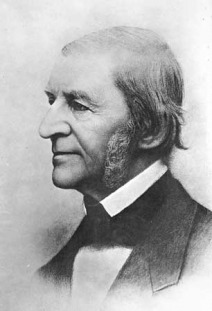Hyperbole
a deliberate, extravagant, and often outrageous exaggeration. It may be used for either serious or comic effect. Macbeth is using hyperbole in the following lines:
. . . .No; this my hand will rather
The multitudinous seas incarnadine,
Making the green one red.
Concord Hymn
Ralph Waldo Emerson
By the rude bridge that arched the flood,
Their flag to April’s breeze unfurled,
Here once the embattled farmers stood,
And fired the shot heard round the world.
The foe long since in silence slept;
Alike the conqueror silent sleeps;
And Time the ruined bridge has swept
Down the dark stream that seaward creeps.
On this green bank, by this soft stream,
We set today a votive stone;
That memory may their deed redeem,
When, like our sires, our sons are gone.
Spirit, that made those heroes dare
To die, and leave their children free,
Bid Time and Nature gently spare
The shaft we raise to them and thee.
Ralph Waldo Emerson wrote the poem “Concord Hymn” in dedication of the Obelisk, a battle monument commemorating the valiant efforts put forth by area citizens on April 19, 1775. His use of hyperbole in line four, “And fired the shot heard round the world”, parallels the historical background of the poem, the American Revolution. That line has been used to describe the impact that day had on American history.

"A great man is always willing to be little. " ~Ralph Waldo Emerson
Ralph Waldo Emerson

The son of a Unitarian minister, Emerson spent a sheltered childhood in Boston. During his youth the publications of the German Higher Critics and their progeny, as well as translations of Hindu and Buddhist poetry, were causing controversy in American academic circles. Emerson's class at Harvard Divinity School was affected by these influences; consequently, upon assuming the pastorate of a Boston church in 1829, Emerson experienced many doubts concerning traditional Christian belief. He resigned from his pulpit in 1832, moved to nearby Concord, and then spent the next few years studying and traveling in Europe. After visiting a Paris botanical exhibition, Emerson resolved to be, as he termed it, a "naturalist." Upon returning to the United States, he began his career as a lecturer in the country's new lyceum movement. During the late 1830s and early 1840s, Emerson published the works that present his thought at its most idealistic and optimistic. The lyrical essay Nature (1836), a pamphlet repudiating both materialism and conventional religion, declares nature the divine example for inspiration and the source of boundless possibilities for humanity's fulfillment. The American Scholar, an address delivered before Harvard's Phi Beta Kappa Society in 1837, attacks American dependence on European thought and urges the creation of a new literary heritage. Emerson's Divinity School Address, delivered at Harvard in 1838, caused tremendous controversy for renouncing the tenets of historical Christianity and defining Transcendental philosophy in terms of the "impersoneity" of God. The doctrines formulated in these three works were later expanded and elaborated upon in his Essays (1841) and Essays: Second Series (1844), of which "Self-Reliance," "The Over-Soul," and "The Poet" are among the best-known.
Emerson became identified with the Transcendental movement in the 1840s, serving as its spokesperson, and as founder and guiding force of that group's quarterly periodical, the Dial. Conceived as "a medium for the freest expression of thought on the questions which interest earnest minds in every community," the Dial was published for a small readership from 1840 to 1844, when it folded. Introducing the public to the writings of Amos Bronson Alcott, Margaret Fuller, and Henry David Thoreau, a group who shared Emerson's philosophy, the journal also published Emerson's first poems. The merits of his poetry, collected in Poems (1847) and May-Day, and Other Pieces (1867), are subject to much critical debate. Prominent among them are "The Rhodora," "The Sphinx," "Brahma," "The Humble-Bee," and "Threnody." But the poem best known to the American public is one of his earliest works, the "Concord Hymn," which celebrates "the shot heard round the world" of the Battle of Concord, during the American Revolution.
Emerson's poetry written from the era of the Dial onward, as well as his prose works dating from Essays: Second Series, chart a steady decline in the author's idealism and give rise to an emerging recognition of mortal limitations. The Conduct of Life (1860) perhaps best expresses his humanistic acquiescence to the reality of worldly circumstances. Other important later works include Representative Men: Seven Lectures (1850), a series of essays on the men who most closely fit Emerson's ideals--including Plato, Napoleon, and Shakespeare--and English Traits (1856), a work hailed by his friend Thomas Carlyle as an accurate portrait of English social manners in the midVictorian era. Society and Solitude (1870) marks the beginning of Emerson's decline as an essayist. He spent his last years in Concord, writing little, but recognized throughout America as a philosopher of great stature.
(http://www.rwe.org/index.php?option=com_content&task=view&id=221&Itemid=256)
